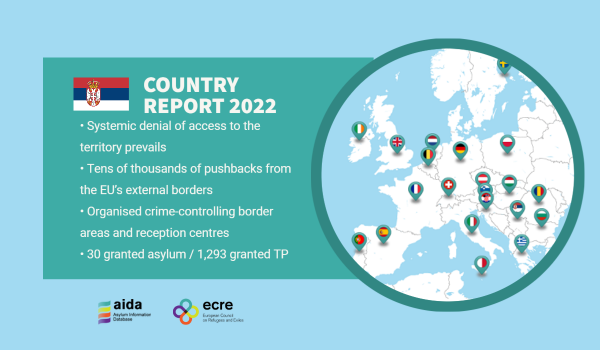The updated AIDA Country Report on Serbia provides a detailed overview on legislative and practice-related developments in asylum procedures, reception conditions, detention of asylum seekers, the content of international protection, as well as procedure for and content of temporary protection in 2022.
In 2022, almost 120,000 refugees and migrants were registered by state authorities, meaning the number of arrivals doubled compared to 2021. This number, however, does not include thousands of Ukrainian refugees who transited through Serbia and the significant number of Russian citizens who fled in fear of forced military recruitment. Only 320 persons applied for asylum, although 4,000 registration certificates were issued, confirming the trend observed in previous years of Serbia being mainly a transit country for people wishing to reach EU countries. In 2022, the Asylum Office delivered 248 decisions regarding 352 asylum seekers. Out of that number, 48 decisions regarding 62 asylum seekers were rejected in merits, while 20 decisions granting asylum to 30 asylum seekers were delivered in the same period. The recognition rate remained extremely low, with only 9% of cases receiving a positive decision. Additionally, no cases of family reunification were registered.
The systemic practice of denying access to the territory, often through pushbacks and other forms of collective expulsions from Serbia to North Macedonia and Bulgaria continued. From 2016 to the end of 2022, a total of 227,183 cases of ‘prevention of illegal entries’ were reported by national authorities; at least 45,965 were registered just in 2022. People who are refused entry are arbitrarily detained in the transit zone, for a period that ranges from several days to several weeks, without being issued detention decisions, not being granted access to rights, including lack of access to a judicial remedy to challenge the lawfulness of their detention order.
As Serbia is surrounded by countries at the EU’s external borders, at least several hundred pushbacks from Hungary, Romania and Croatia towards Serbia happened on a daily basis. From Hungary, almost 160,000 instances of pushbacks were reported by Hungarian immigration services, while several thousand more pushbacks from Croatia and Romania were reported by UNHCR and CSOs. Most incidents were described as violent, involving different forms of physical or psychological ill-treatment. It can be said that at Serbian borders (both at entry and exit points) a generalised lack of respect for the rule of law and for the fundamental rights of refugees from Africa, the Middle East and other parts of Asia can be observed. Organised crime, mostly dedicated to smuggling activities, has flourished: different criminal groups are controlling both border areas and reception centres. Numerous violent incidents among smuggling groups – including armed shootings – were reported, as well as instances in which refugees and migrants were mistreated by said groups inside and outside official reception facilities. Numerous reports indicate the involvement of police officers and interpreters in these criminal groups.
In stark contrast to these practices, there were no reports or recorded incidents regarding people fleeing Ukraine being denied access to the territory. According to the Serbian Commissariat for Refugees, from 24 February 2022 until 24 February 2023, around 148,000 Ukrainian citizens entered Serbia, and around 26,000 were granted some form of temporary residency. Between March 2022 and April 2023, the total number of persons registered as temporary protection beneficiaries was 1,293. Out of the total number, 1,237 were Ukrainian nationals, 28 Russian nationals and 28 other nationals (China, Latvia, Bosnia and Hercegovina, Belarus, Georgia, Uzbekistan and Armenia).
For further information:
- Find comparative information in the Asylum Information Database (AIDA) managed by ECRE.

